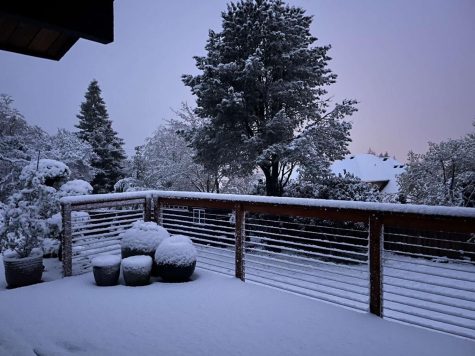Snow Day in April: A Sign of Climate Change’s Presence

It is known that April showers bring May flowers, but what about April snow? April snowfall may be another sign that climate change is here.
On April 11, Jesuit students were delighted to find that school was closed due to inclement weather in the greater Portland area. This extra day off school provided many students with an unexpected respite.
“The snow day was definitely a surprise, but I did like the day off school,” senior Ryan Spuck said. “I didn’t even know it was supposed to snow that day!”
The 2-6 inches of snow received in the Portland-Metro Area occurred on the latest date in over 80 years and was the first measurable snow in April since the city began keeping record in 1940.
Breaking branches and downing trees, the snow closed roads—including parts of U.S. 26–shut down schools, and left about 100,000 individuals without electricity at the power outtage’s peak.
In addition to having immediate ramifications on the city’s functioning, this snow also gives insight into the long-term ramifications of climate change. Portland’s record-breaking snow serves as a reminder that climate change is already affecting Oregon’s usual weather pattern, dispelling the misconception that climate change does not always mean hotter year-round temperatures.
Despite receiving snowfall this spring, according to a report by Climate Central, snowfall is decreasing on an average of 80% in fall months and 66% in spring in the U.S., due to increasing average temperatures across the country.
In the Northwest, snow has declined at 91% of recording stations during the fall. Additionally, a study conducted by Portland State University found that snowfall among Northwestern mountains has been decreasing, especially at mid-level elevations.
This decreased snowfall has detrimental consequences, especially to Oregon, whose water supply is largely dependent on snowmelt from the Cascades.
Portland’s April snowfall stands out among these trends, signifying that while on average climate change decreases snowfall patterns, it also causes patterns to become less predictable, more erratic, and more extreme.
According to the Environmental Defense Fund, melting sea ice in the arctic is predicted to weaken the jet stream of air circulation, allowing for more frigid air to penetrate farther south than normal. Climate change also changes circulation patterns, affecting natural snowfall patterns, the time of year they occur, and the amount of snow that falls.
In addition to changing air patterns, the Earth’s increasing average temperature creates more evaporation, adding more moisture to the atmosphere. This means that when areas do get blasts of frigid air, the air has enough moisture to produce snow.
Portland’s rare snowfall came just days after an unusually hot day, with temperatures reaching a high of 75˚ F on April 7. This increased temperature swing is another symptom of climate change. With changing atmospheric weather patterns, there may be less gradual changes in temperature, what is referred to as the “whiplash” effect of climate change.
Diya Balakrishnan, senior and leader of Jesuit’s climate advocacy club, Green Team, noticed this volatile weather change and questioned what it could mean for the stability of our environment.
“This past Monday morning, when I woke up to a sea of white outside my window, I began to wonder if maybe this cold weather really is such a good thing or not,” Balakrishnan said. “Is it really normal to have 80 degree weather in April of one year and below freezing temperatures in the next?”
Not only is it not normal, but it can be detrimental to human and environmental health. With temperature and weather swinging rapidly from extremes, individuals, animals, and plant life have little time to adjust, making them more vulnerable. In areas with consistently hot temperatures, individuals were able to improve their tolerance and were less vulnerable to heat related illnesses, unlike individuals in climates with alternating hot and cold temperatures.
Looking at the uncertainty of the weather patterns and the larger troubles that volatility brings, Balakrishnan reflects on what we can learn from this recent snow day.
“I no longer reminisce about the warm weather, because those gusts of bone-chilling wind serve as a haunting reminder that from now on, we can never know what to expect anymore,” Balakrishnan said. “Climate change is here, whether we want to admit it or not.”








